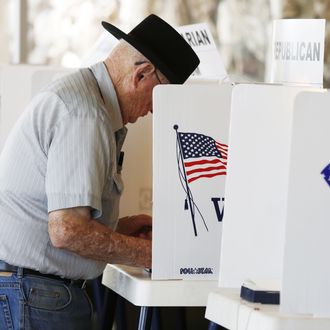
As of this writing, Hillary Clinton is leading Donald Trump in the RealClearPolitics poll of polls by 2 percentage points. Even factoring in the effect of Sanders Democrats who aren’t ready to say, “Girl, guess I’m with her,” this lead feels small. After all, isn’t Trump despised by virtually every nonwhite voter in the country? This is a presidential election, not Oscar balloting — how can winning the votes of old white people possibly get Trump this close?
In the Upshot Thursday morning, Nate Cohn provides one possible answer: The American electorate is much whiter than most analysts have realized.
Unless you’re pursuing a political-science Ph.D., virtually every analysis you’ve read of American elections has been based on data from exit polls — the surveys taken at polling places on Election Day that provide a rough estimate of the electorate’s demographic breakdown. But for more than a decade now, academic political scientists have been calling the accuracy of these polls into question: According to research by the University of Florida’s Michael McDonald, exit polls depict an electorate that is younger, better educated, and more diverse than the one that actually exists. When you compare exit-poll results to other data sets — like the Current Population Survey and compilations of local voter-registration records — profound differences in the composition of the electorate emerge. And political scientists generally agree that these alternative measures are more accurate.
To try and provide a more holistic estimate of the 2012 electorate, the Upshot built a statistical model that integrated census data, actual results, and 15,000 interviews from preelection surveys. According to exit polls, Barack Obama won a mere 25 percent of white voters without a college degree; according to the Upshot model, he won 34 percent.
One popular narrative around Obama’s victories is that they proved the diminishing relevance of white working-class voters to Democrats in national elections. Even with a declining share of blue-collar whites, Democrats could win with “the coalition of the ascendant” — unmarried women, young people, and nonwhite voters. But if exit polls dramatically understated the president’s white working-class support, that narrative becomes less compelling.
The Upshot’s analysis finds that the first black president did perform historically poorly among whites in the South (for God knows what reason). But throughout the rest of the country, Obama won 46 percent of white voters, more than John Kerry and Al Gore in previous elections.
This suggests America’s changing demographics were not responsible for Obama’s reelection. Even if the American electorate stayed as white as it was in 2004, Obama still would have defeated Romney on the strength of his white support in New Mexico, Iowa, and Colorado.
Obama’s underappreciated dependence on white voters is ostensibly good news for a Republican like Trump, whose appeal appears to be monochromatic. According to Cohn, Trump leads Clinton by 27 points among white voters without a college degree, in an average of recent national surveys. Romney won that demographic by just 19 points.
But viewed from another angle, the Upshot’s revision of the 2012 electorate could make Trump’s task this fall even more difficult: White working-class voters are, apparently, less conservative than previously thought. And if Hispanic voters and young people have been overrepresented in exit polls, there’s an even larger turnout gap among these liberal demographics than previously believed. If early reports of an upsurge in Hispanic voter registration prove true — and the electorate actually becomes as diverse as it looked in 2012’s exit polls — Democrats could see a historic landslide.
Of course, none of this demographic hairsplitting will matter much if Trump remains convinced that he can win the White House without a campaign staff or data operation but by merely putting tons of Make America Great Again signs in the front yards of upstate New York.
But you should read the Upshot’s full analysis anyway. Its implications extend far beyond 2016.






























